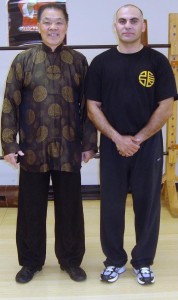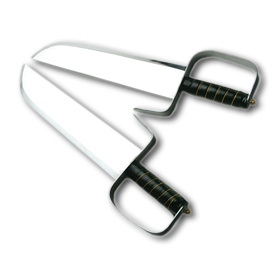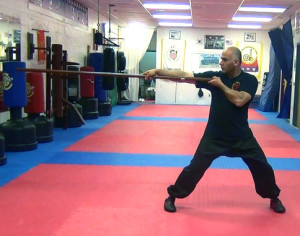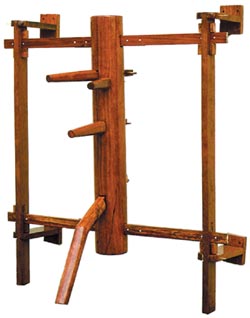Traditional Wing Chun

GM William Cheung & Sifu Ismail Agcicek
The origin of Wing Chun Kung Fu can be found in the turbulent, repressive Ching dynasty of over 250 years ago. It was a time when 90% of the Chinese race, the Hons, were ruled by the 10% minority, the Manchus. The Manchus placed a great amount of unjust law on the Hons. For instance, all the female Hon infants were made to bind their feet so that when they grew up they would be dependent upon their parents or husband. The work opportunity of the Hons was also restricted. They were unable to hold office in Government higher than a certain level. Heavy tax burdens were placed on the country so that the Manchus could have economic control of the Hon people. Kung Fu training was also banned for the Hons, however the Manchu Government was adopting the Hon culture. They respected the Shil Lim Temple as a Buddhist sanctuary.
When all weapons were outlawed by the Manchus, the Hons began training a revolutionary army in the secret art of Kung Fu. The Shil Lim Temple became the secret sanctuary for preparatory trainings of a classic style which took 15 to 20 years to master.
To develop a new form, one which would have shorter training time, five of China’s grandmasters met to discuss the merits of each of the various forms of Kung Fu. By choosing the most efficient techniques from each style, they developed training programs that would develop an efficient martial artist in 5 to 7 years, one third the original time. However before this new form could be put into practice, the Shil Lim Temple was raided and burned by the Manchus.
Ng Mui, a nun, was the only survivor of the original five grandmasters. She passed her knowledge onto a young orphan girl whom she named Wing Chun. The name represented “hope for the future”. In turn Wing Chun passed her knowledge on to her husband. Through the years the style became known as Wing Chun. Its techniques and teachings were passed onto a few, always carefully selected students.
In 1950 Yip Man started to teach Wing Chun in Hong Kong. One of his first students was the new Grandmaster, William Cheung, head of the World Wing Chun Kung Fu Association.
Empty-Hand Forms
Forms are prearranged sets of movements used to develop the fundamentals of a martial art. Each movement within a form is used within the specific martial art for defensive or offensive purposes. Each movement is combined with another movement to form techniques. Techniques are then combined with other techniques and applied to offensive or defensive maneuvers. Through this method students are taught the principles and the fighting philosophy of the martial arts.
Wing Chun has six forms. Three empty-hand forms, two weapons forms, and one form performed on the wooden dummy. The three empty hand forms are Siu Lim Tao, Chum Kiu, and Biu Jee. (Cantonese dialect of Chinese will be used to describe many terms). The two weapon forms are the Baat Jaam Do form or more commonly known as the butterfly sword form and the Luhk Dim Boon Kwan or 6 1/2 Point Dragon Pole form. There is an advanced version of the Siu Lim Tao form that hasn’t been included in the count.
Butterfly Swords
The butterfly sword is a weapon used primarily by martial artists of southern China. The blade length of the weapon is equal to the fist and the forearm, and a guard is fixed to its hilt to protect the hand. The special length of the blade is designed to allow for better maneuvering. For instance, if the blade is longer than the length of the fist and the arm, it could not be able to be rotated inside the arms. However, the shape of the butterfly sword and the way of its use differs in northern China. With the northern Chinese butterfly sword, the footwork of the user in kicking is stressed; but the butterfly swords in southern China are used chiefly in close-quarter fighting because of their short length, with emphasis placed on precision and the coordination of both swords at the same time. One modern adept of hung gar style, Wong Fei Hung, was especially noted for his skill with this weapon.
Wing Chun eight slash butterfly swords are also called Wing Chun Baat Jaam Do. The name Baat Jaam Do was derived from the initial intention of the originator who designed the striking technique mainly aiming for the wrist, elbow, knee and ankle. The purpose was to main the opponent rather than to kill since the wing chun Baat Jaam Do was originated from the Shaolin temple and used by the monks and nuns of the temple in their travels. They frequently carried sums of money donated by their worshippers. Often they would be met by bandits who intended to rob them. The monks were prepared for this, and they were equipped with butterfly swords hidden in the side of their boots. When they were confronted by the bandits, they would pull out the swords to defend themselves. Since their religion did not allow them to slaughter anyone, their initial target was to maim their opponents on the wrists, knees and ankles. In the Ching Dynasty (A.D. 1644-1911), China was ruled by the Manchu invaders. It was a time when 90 percent of the Chinese, the Hons, were ruled by the ten percent minority, the Manchus.
When all weapons were outlawed by the Manchu Government, the Manchus gained full control of China. They enforced many unjust laws on the Hons. For instance, all the female Hon infants were made to bind their feet so that when they grew up they would be restricted in their movement and they would have to be dependent upon their parents or their husband. They restricted the work opportunity of the Hons. The Hons were unable to hold office in the government higher than a certain level. They placed heavy tax burdens on the country so that they could have complete economic control of the Hon people. Kung Fu training was also banned for the Hon people.
However, the Manchu Government adopted the Hon culture. They respected the Shaolin Temple as a Buddhist sanctuary. The Hons began training a revolutionary army in the art of kung fu, using the Shaolin temple as the secret training place. In the traditional Shaolin system it would take 15 to 20 years to train a kung fu master. The need to develop a new and more effective style of kung fu became critical when some of the existing kung fu masters surrendered to work for the Manchu Government. Five of the Shaolin grandmasters planned to develop a new form, one which would have a shorter training time and would be more effective than all the other systems developed before. The five teachers met to discuss the merits of each of their particular systems of kung fu and chose the most efficient training method from each system. They developed the principle and the training program of wing chun that would take only five years to master. They called this system Wing Chun, its name meaning “hope for the future.” However, before this new system could be put into practice, the Shaolin temple was raided and burned by the Manchus. Ng Mui, a nun, was the only survivor of the original group of five. She passed her knowledge onto a young orphan girl whom she named Wing Chun.
Along with the development of the wing chun system, the butterfly sword (Baat Jaam Do), was chosen as the only weapon in the wing chun system because the length of the Baat Jaam Do made it easy to conceal. It could be used as a extension of the arms, and they were the most deadly and effective weapons of all. This was because the Baat Jaam Do system emphasized the training of coordinating the two swords, the training of the eyes, wrist and footwork. The principle was based on the fact that every defense was accompanied by a counter attack, and every attack was accompanied by a trapping, parrying or immobilizing move of the other sword. Plus, it was designed to use the ingenuity of the wing chun footwork to its fullest extent, making it the champion of all weapons.
Dragon Pole
The Dragon Pole has the advantage of its length and linear movements in attack with a minimal circular movement in defense. This technique combined with the most efficient footwork in both attack and defense allows the exponent to move in and out of range like lightning. In fact, it is said that once you hear the first impact of the Pole, the victor has already been decided.
Origins of the “Look Dim Boon Kwan” – Dragon Pole
As far back as 3000 B.C., the staff and the long pole were used in hunting as well as in battle. The staff is a stick between five and six feet in length, both ends of the same diameter. The long pole can be as long as 13 feet, with one end tapered. These weapons were easy to construct and were very popular in ancient days.
With the discovery of bronze and iron, the staff and long pole were modified into weapons such as spears, Kwan Dao (big choppers), and various versions of the long stick with metal casting at the end.
The use of the staff and long pole was also popular among the Shaolin monks during the early Sung Dynasty (A.D. 960-1279). During that time the monks were involved in helping the first emperor, Sung, establish his kingdom. The staff and long pole were used extensively by the monks, who, because of their religion, did not like sharp edged weapons that would inflict undue injury to their enemies. Even after the Sung Dynasty, the Shaolin monks continued to favor the use of the staff and long pole. In the Manchu Dynasty (1644-1911), the monks used these weapons to defend themselves from the Manchu Government’s siege on the Shaolin Temple.
There were many forms of staff and long pole in the Shaolin style, but the most effective was the “Look Dim Boon Grun” i.e. Six-and-a-half-Strike Dragon Pole, originated by Grandmaster Gee Sin.
According to Chinese legend, Grandmaster Gee Sin was also one of the five Grandmasters who developed the Wing Chun style. But Yim Wing Chun, who became the only heir to the Wing Chun style, and after whom it was named, did not learn the dragon pole as part of her Wing Chun training. She completed her training with Grandmaster Ng Mui, having learned only the empty-hand techniques and the butterfly swords which she passed on to her husband Leung Bok Cho.
The Dragon Pole descended from Grandmaster Gee Sin through three generations of his disciples to Wong Wah Bo, and was reunited with the Wing Chun style by another twist of fate. Yim Wing Chun’s husband, Leung Bok Cho, in searching for someone to whom he could pass on the Wing Chun system chose on of his nephews. Coincidentally, this also turned out to be Wong Wah Bo, the third generation heir to the dragon pole techniques of Grandmaster Gee Sin.
Wong Wah Bo was a very popular opera star on a floating opera barge called The Red Boat. One day, Leung Bok Cho went to the Red Boat to see the opera. Leung and Wong got together after the show, and came to the agreement that they would have a friendly martial arts contest. If Leung could defeat Wong easily, then Wong would undertake to learn the Wing Chun system.
The two confronted each other on the stage of The Red Boat. Wong was armed with a 12 foot dragon pole and Leung had a pair of butterfly swords each measuring 14 inches. Since Wong considered himself as having the advantage, he asked Leung to attack first. Leung brandished the pair of butterfly swords to begin his attack. Wong was very cautious in defending because the swords were sharp and Leung’s technique was very tight and swift. Though he fought with all his might, Wong found it very difficult to fend off Leung’s attack. He was forced to retreat to the edge of the stage. Now, Wong could not use the most deadly technique of the Six-and-a-Half-Strike Dragon Pole to deal with the situation. When Leung aimed a double slash with both swords at Wong’s head, Wong raised his pole in a technique called Bong Kwan – (Wing block) to neutralize the assault, and followed up with a lower jab to Leung’s leg. This was one of the most efficient dragon pole techniques in the Six-and-a-Half-Strike Dragon Pole because block and counterattack were almost simultaneous. Wong used it quickly and thought this would surely bring a speedy victory. Nevertheless, quite unexpectedly, Wong felt something cold touch his hand. He looked down and found the sharp edge of a butterfly sword resting on his wrist. He had no alternative. He dropped the dragon pole and admitted defeat. Wong fell to his knees and begged to be Leung’s student so that he could learn the Wing Chun system.
From that brief encounter Leung realized that he had chosen well and that Wong had the potential of becoming the best. After Wong mastered Wing Chun, he improved the Six-and-a-Half-Strike Dragon Pole by combining it with Wing Chun and making its techniques much more effective.
Wooden Dummy
Legend has it that in the days of the Shaolin Temple, there was a tunnel filled with 108 wooden dummies, and the monks who completed their training were required to pass through this tunnel as one of their final exams. Each one of these dummies performed a certain technique, which the “graduate” monks had to neutralize on their way out of the temple.
When the Shaolin Temple was destroyed, Ng Mui, the Buddhist nun credited with founding Wing Chun Kung Fu, escaped. In deference to her training at the Shaolin Temple, she incorporated a training set using a single Wooden Dummy. This dummy set contains 108 combat techniques, each one supposedly to represent the 108 dummies that were in the Shaolin Temple.
Whether or not these legends are true, it is true that the Wooden Dummy set in traditional Wing Chun is an excellent way to develop the skills and co-ordination needed to become a proficient fighter.
The Wooden Dummy is used to develop timing, arm and leg co-ordination, proper use and application of force, distance, judgement, footwork and to teach practitioners how to flow smoothly from technique to technique. It is also used to toughen the limbs, although this is not the primary function of the dummy.
Wing Chun Kung Fu is a system that does not rely on strength and brute force; rather it stresses development of skill and co-ordination to have the practitioner deflect and redirect an opponent’s attack, while simultaneously countering with his/her own attack. Deflection and redirection is achieved with correct positioning, requiring good footwork as well as co-ordination of the arms and legs, so that they work together to redirect an oncoming attack yet leave the practitioner in a position to counter at the same time.
All fighting techniques in Wing Chun come from the techniques in the Wooden Dummy. Dummy training allows the Wing Chun practitioner a way to correctly train the body in performing techniques. The amount of power one uses at certain times of a technique, as well as the timing of delivering such techniques can be drilled repeatedly on the dummy. Speed is improved because one can drill a series of movements over and over, creating the muscle memories needed to perform techniques automatically. Accuracy is refined because the practitioner learns how to correctly position his/her body in relation to the dummy (i.e. opponent) so that both arms can be used simultaneously. Footwork and mobility are enhanced, as the practitioner is forced to move from one side of the dummy to the other, moving in and out as well as laterally. Although working with a “static” partner, the Wing Chun practitioner learns how to combine footwork patterns smoothly with arm movements that deflect and attack, developing skills that are mandatory for successful free sparring. There are 108 Wing Chun wooden dummy techniques, which are grouped into 13 sections. Yip Man thought that some sections were too dangerous to be taught publicly. Therefore, he deleted some sections. There were more sections.
Regardless of the style one practices, one always hears that to be a successful fighter there are certain qualities and attributes that one must acquire. Speed, power, timing and accuracy are always cited as requisites to reach your peak in martial arts. The Wooden Dummy of the Wing Chun system provides the practitioner a valuable tool to achieve those goals.
Chi Sao (Sticking Hands)
Chi sao training develops timing and contact reflexes. Many chi sao techniques do not apply to actual combat, but, through these techniques, the practitioner will develop the fundamental skill of contact reflexes which is the key to victory in combat. The other benefits of chi sao are, close distance coordination, focusing with the eyes, mobility, balance, timing, accuracy, control of the opponent’s balance, and Chi power.
We all know that force has only one direction, but the force developed in chi sao can be interpreted as a force with several directions, like a guided missile following its target. This force can only be acquired from proper wing chun chi sao exercises.
In combat, a temporary contact is made with the arms after a block or attack. At this contact point an opponent’s next move can be detected as a transmitted vibration.
Chi Sao will teach you how to use both sides of your brain. The right side of your brain controls the left side of your body and the left side controls the right side. You will learn how to use both arms interdependently. A pianist can play one rhythm/melody with the left hand and another with the right hand. Try rubbing your head with one hand and patting you stomach with the other and vice versa. Now try doing it faster and faster as in a real fight. Get the idea?





Leave a Reply